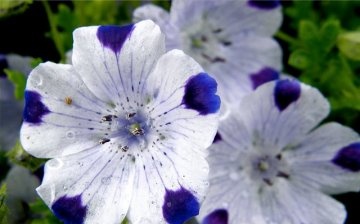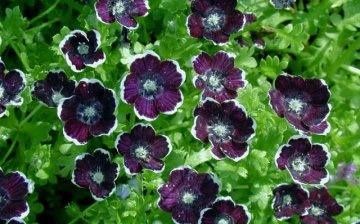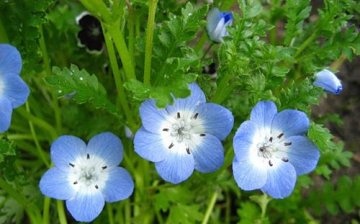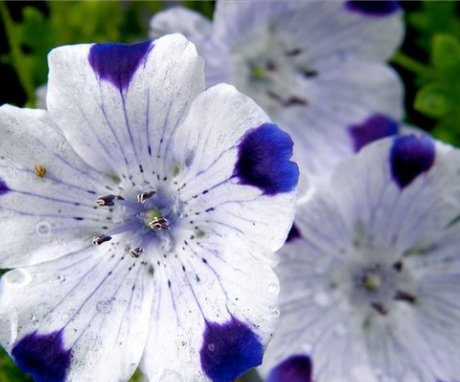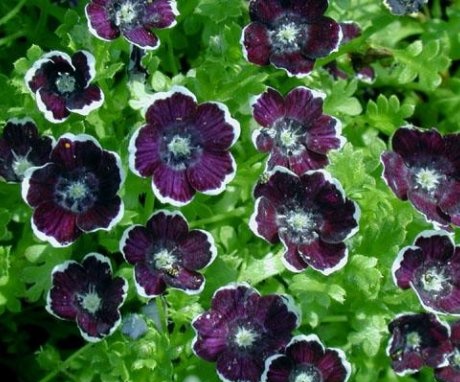Growing nemophila - the secrets of success
Most Russian gardeners are not yet familiar with this beautiful annual. The homeland of nemophila is North America, so you can often hear another name for this plant - American forget-me-not.
Content:
- Types of nemophila used in gardening
- Secrets of growing nemophila
- The use of nemophila in landscape design
Types of nemophila used in gardening
Nemophila is a ground cover annual fluffy plant with flowers 2 to 4 cm in diameter and openwork, pinnately dissected and slightly silvered leaves. In nature, there are about 100 species of nemophila.
The most common varieties in modern horticulture are:
- nemofila Menzis or "Children's blue eyes". The flowers are bell-shaped, wide open, about 4 cm in diameter, solid sky blue or with a white center. Coloring is white-blue and completely white;
- nemophila spotted. The flowers are also broadly campanulate, white with a light purple tint and purple spots at the end of each petal;
- non-philistine "Discoidalis" or "Penny Black". The flowers are deep purple in color, so dark that it seems that the color is completely black, which is also emphasized by the bright white edging of the petals and white stamens. Such a sharp contrast makes the flower extraordinarily effective;
- nemophila "Atomaria" or "Snustorm". White flowers with small black dots at the tips of the petals;
- non-philistine "Coelestis". White flowers are edged along the edges of the petals with a blue border.
Nemophila dissolves its delicate flowers at the end of June and blooms until the middle of September, pleasing the eye with its beauty throughout the summer.
Secrets of growing nemophila
In order for nemophila to bloom profusely, you should know the main secrets of its cultivation.
Plant nemophila, like other annuals, with seeds. To see your flower beds with nemophila blooming in June, you need to sow seeds in March-April. The advantage of the American forget-me-not is frost resistance, so the seeds can be sown immediately in open ground.
The soil for planting should be provided with good drainage and be nutritious. Sowing is carried out rarely, the seeds are covered with a layer of earth no thicker than 0.5 cm. Nemophila is a moisture-loving plant, therefore, during the period of seed germination and further growth, it is necessary to organize regular watering.
After the first shoots, the plants are weeded so that the distance between the bushes is from 10 to 20 cm, which will allow the nemophile to grow freely and create a continuous carpet. When the seedlings are blooming, it is necessary feed its complex mineral fertilizer, to provide a weed-free soil around the plants.
Although nemophila loves shady places, planting it in full shade is not recommended, since the flowering will not be so lush.
In dry weather, Nemophila is watered abundantly every evening. The plant cannot stand the summer heat, therefore, under such weather conditions, the roots are covered with a thick layer of mulch.
The use of nemophila in landscape design
Charming nemophila is an excellent material for creating amazingly beautiful compositions in the garden.
From several varieties, nemophila create ridges in combination with other low-growing plants.A special effect is achieved over a large area, by planting nemophila in the form of waves with alternating plants of different colors. When this splendor blooms, gardeners get an original "sea" corner in their garden.
Nemophila is great for edging flower beds. In the case when the flower bed is placed on a green lawn, then white plants expressively highlight its beauty, and nemophila plantings of various colors are used for edging garden paths. If for these purposes ground covers of pink, red, orange, yellow colors are introduced, then garden paths turn into a real work of garden art.
With the help of nemophila, they create flowering lawns, which, by design, are close to natural mountain ones, and are also used for coastal decoration of ponds and streams. Nemophila's desired guest is on the alpine slides, where she successfully fills the spaces between stones and coniferous plantings.
Acting as an underbrush, the undersized nemophila with a rug covers the soil around the vines and tubs, emphasizes the beauty of the rose garden, large plants with double flowers and other complex inflorescences.
Nemophila goes well with bells, daisies, phloxcreating different color schemes. She looks colorful and fun together with nasturtium and medicinal calendula.
Sharply contrasting compositions are achieved with the help of nemophila "Penny Black" and other plants with flowers of white, yellow and other light colors.
In addition to garden plantings, nemophila is grown as a potted plant, both alone and in combination with other plants of contrasting color.




